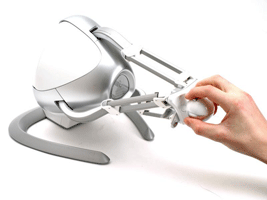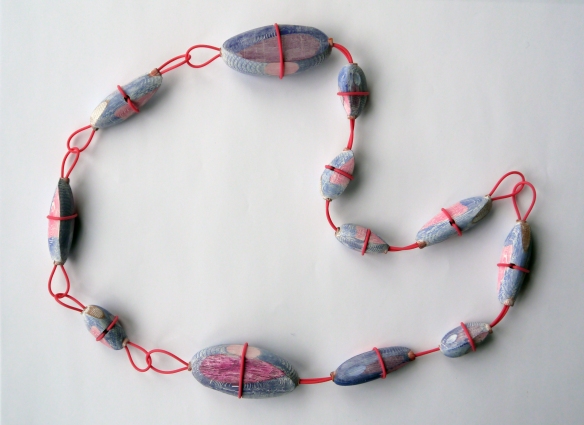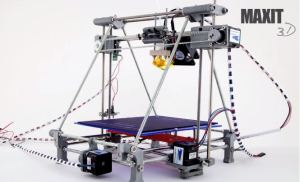Fabbaloo published an article about Bits from Bytes about getting a new website and unveiling a RapChick at Euromold last week! What is a RapChick?
The new RapChick is a 3D Printer Kit designed ‘especially for female users in response to the growing numbers of women engineers and creators within our community. The RapChick features pink accents and unique branding that will appeal to this rapidly expanding, underserved audience’. Unlike Fabbaloo my immediate response to the above description was not favourable and neither were the first 2 comments to their article. Why is it assumed that woman engineers are not capable of building the Rapman? Many creators are capable too but there are those who also have better/more pressing things to do, like design, make and market, than spend precious creative time, and money, building for the technical exercise and a few quid off. A good few like myself really don’t want to grapple with techie stuff: we don’t understand it nor do we want to. But we want to 3D print.
The RapChick’s ‘pink accents’ did made me see red as it seems that pink plus the branding were the only design differences between the RapChick and the Rapman! There is an excellent article by Femmeden http://www.femmeden.com/pdf/SmartDesign_SexontheBrain.pdf that explains precisely why I was incensed. And all designers should read it.
Seriously, I do applaud what BfB are doing but to truly democatise 3D printing (as BfB say they are doing), they have to also appeal to all rapidly expanding, underserved audiences. For non technical groups Rapman and RapChick kits are not the way to do this.
Development must be on usability and understanding how to include people of all ages who have different learning styles, requirements and preferences who want to engage with this very exciting technology. So thank you, Shapeways, Sculpteo, and I am sure Ponoko – I haven’t experienced their 3D services yet – for making the route to 3D printing so straightforward.
Thre is a remaining barrier to more people being able to use 3D printing: how to create that virtual model. CAD is not suitable for many on many levels. It is prescriptive, has a huge learning curve, designed for operatives working with it almost full time, complex interface, too many functions that will never be touched or used, too expensive and difficult to justify when used sporadically in conjunction with other tasks such as making and marketing. It does not fit comfortably, for example, with the way many in the applied arts work within their disciplines of ceramics, jewellery, metalwork, furniture, accessories etc.
The main influencers to many budget holders, responsible for selecting and recommending 3D hardware and software for schools, colleges, workshops, fablabs, are themselves CAD users and do not fully grasp the divide that exists. Many in the arts have turned technophobic, overwhelmed by complexity and prescriptiveness, becoming a barrier unto themselves and teachers for their pupils to the extent that digital technologies are now off their radar.
I only fully grasped why our haptic Cloud9 3D sketch modelling software was special when I read the femmeden article (link is above) a few years ago – Cloud9 is INCLUSIVE. CAD isn’t. By using a haptic device to replace the 3D mouse, to give the user 3D ‘virtual touch’ and movement in 3D, interaction in the digital environment remains familiar. Cloud9 is so intuitive and free flowing, serendipity is a default. It is easy to learn and to use, and fun (virtual 3D touch is special), caters for all stages of creativity (amateur to professional), can be picked up quickly again after a long break as the non complex interface taps into our more natural way of interacting in 3D, is being developed with the feed back from stakeholders and other users about what they want and need and how they want to work, and unbelievably the software and the haptic device bundle together costs under £500.
It can also be difficult to justify even this until the enormous potential of 3D printing is understood! And from Cloud9 you can 3D print your model directly. £500 then becomes a no brainer. Design companies internationally are buying Cloud9 as it fits into their design pipeline and complements CAD. Schools are purchasing: all kids should now be able to access 3D technologies. Colleges are buying into it too.
Previously I spotlighted Farah Bandookwala. She uses Cloud9 with Rhino, and Shapeways for tangible output for her whole Masters Degree Show. Have a look on her website: http://www.farahb.com. See Shapeways, Ponoko, FoC and so on for the rising numbers of applied artists working internationally who are using 3D printing to create wonderful pieces of work.
Creativity and the inspiration for this fantastic work can be sparked off by having a good understanding of the process of 3D printing and the properties of the material used. The BfB products are excellent for seeing the build up happening and therefore understanding the affordances and constraints. Plus the resulting parts are inexpensive enough to experiment and play with so this valuable part of creativity is not checked by any ‘preciousness.’
What many of us need then is not so much the Rapman kit but a ready built 3D printer with easy processing of 3D data at an entry level price in a workshop/fablab nearby as this way it would get more usage and more people engaged.
3D virtual world is indeed very bright and tangible.
Bits From Bytes








